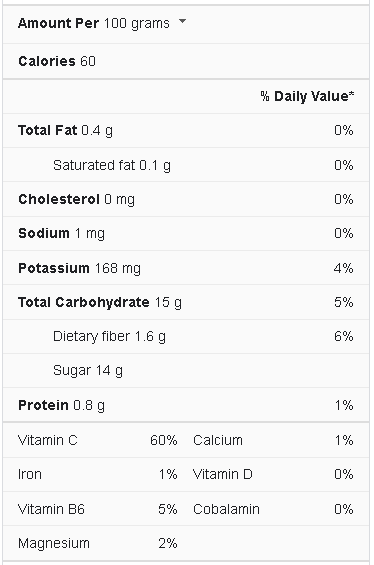Mangoes are tropical fruits that are not only juicy, tasty, and appealing to the eye but also nutritious. They’re high in vitamins, minerals, and antioxidants, and they’re a low-fat, low-carbohydrate source. They used to be challenging to come by and were thought to be unusual. Mangos, on the other hand, are now available all year. Mangoes are delicious, luscious fruits with a variety of health benefits. They are well-liked throughout the world. To know mango nutrition facts, read further.
A tropical stone fruit, the Mango belongs to the drupe family. A fleshy outer part surrounds a shell, or pit, in this type of plant food. There is a seed in this pit. Olives, dates, and coconuts are all members of the drupe family. Mangoes come in a variety of shapes and sizes. Color, shape, flavor, and seed size all vary. The Mango’s outer peel can be green, red, yellow, or orange, while the inner meat is predominantly golden yellow.
Mango Nutrition Facts
Mangoes are a nutrient-rich source of carbohydrates packed with vitamin C. They are low in fat, sodium, and cholesterol and contain vitamins A, E, K, potassium, magnesium, and copper.
What are the Benefits of Eating Mango?
Although there are a lot of benefits to eating mangoes and here are some of them:
Vitamin
Mango is high in vitamin A; one cup of Mango has around 25% of the daily required vitamin A intake. This vitamin serves a variety of activities in the body, including those related to the eyes and skin. It also improves the condition of your bones, reproductive system, and immune system.
Mango is one of the best sources of vitamin C in food. This vitamin is necessary for your immune system to function correctly, and it also aids in the development of muscles, tendons, and bones. Because of its high vitamin C content, Mango promotes plant iron absorption. One cup of Mango has 46 milligrams of vitamin C, which is around 60 percent of the daily recommended amount.
Weight Control
When it comes to maintaining a healthy weight, Mango has a lot of promise. According to new research, Mango and its phytochemicals may decrease fat cells and obesity-related genes. Another study found that mango peel, like the antioxidant resveratrol, prevents the production of fatty tissues.
Anticancer
Mango’s micronutrients may help fight cancer, and research on breast cancer, in particular, has shown promise. Mango reduced tumor size and lowered cancer development factors in one animal study. In another trial, Mango slowed the progression of ductal carcinoma, a kind of early-stage breast cancer.
Skin And Hair
Mangoes are also helpful for hair health since they contain a lot of vitamin A. Vitamin A-derived substances aid in the production of sebum, which hydrates the hair. Vitamin A is required to develop all human tissues, including skin and hair. The vitamin C content of 100 grams of Mango is 60%. According to the Dietary Guidelines for Americans, this is most of a person’s daily needs. Enough vitamin C intake aids collagen development and maintenance, giving the skin and hair structure.
How Cut Properly Mangoes?
Here are six simple ways to cut fresh mangoes:
In Half And With A Spoon
Keeping the skin on and vertically slicing off each half away from the pit is one of the simplest methods to cut a mango. Then scoop out the flesh using a large spoon and place it in a basin to slice or consume. You can also portion up smaller spoonful’s to eat one at a time as a snack.
Into slices
To prepare thin mango slices, cut each half of the fruit vertically from the pit with a sharp knife. Then, grab one of the halves in your palm and cut long slices into the flesh using your other hand. Make sure you don’t break the skin and reverse the process with the other half. Alternatively, slice each half on a cutting board instead of cutting each half with your hands. Scoop the slices into a bowl or plate using a spoon.
Into Cubes
The hedgehog method is another name for cubing a mango. Divide the fruit vertically with a knife, then hold one half and slice a grid pattern into the flesh with a knife. Make careful you don’t pierce the skin. Reverse the process with the other half. Peel back the skin on each half of the Mango to reveal the cubed fruit (which should resemble a hedgehog) and pluck out the pieces with your hands. Alternatively, the cubes can be spooned into a bowl.
With A Peeler
Use a vegetable peeler or knife to slice a mango into narrower slices. Remove the skin and make tiny shavings with your peeler or knife across the meat. When you reach the pit, come to a halt and repeat with the other side.
With A Mango Splitter
A mango splitter is a gadget used to cut a mango in half while removing the pit. Place the fruit vertically on a chopping board and center the splitter on top of it to use one. To separate both halves of the Mango from the pit, push the oval slicer into the Mango’s center with your hands.
With A Drinking Glass
When preparing a mango, try using a drinking glass to save time. To begin, cut each half in half using a sharp knife. Then, press the rim of a drinking glass between the flesh and skin while holding one half in your palm with your other hand. Carry on until all of the meat is removed and contained within the glass. Fill a bowl halfway with the flesh and repeat with the second half.
Is it Good to Eat Mango At Night?
Here are some benefits of eating mangoes at night:
- Snacking on a couple of mango slices can help you get to bed faster and provide you with more restorative rest.
- Mangoes’ antibacterial qualities could help to clear mucus and relieve coughing.
- In addition to being a juicy and sweet delight, Mangoes also help decrease blood pressure. A lack of fiber in one’s diet is frequently cited as a contributing factor in developing hypertension and other disorders.
- Mangoes include potassium and magnesium, two elements that help your body retain a steady pulse and relax your blood arteries.
- High quantities of vitamin C in mangoes keep your skin looking youthful and vibrant.
What are the Disadvantages of Mango?
Here are some side effects also of eating excessive mangoes:
- Excessive mango consumption can result in diarrhea. Mangoes are heavy in fiber, and consuming too much of this type of fruit might cause diarrhea. As a result, it is best to consume this fruit in moderation.
- Mangoes have a high sugar content, which might be harmful to people with diabetes. As a result, if you have diabetes, you should get medical advice before using it.
- Some people are allergic to Mango, and they have symptoms such as a runny nose, difficulty breathing, stomach pain, and sneezing. As a result, it is recommended that you get tested for allergies and avoid eating mangoes for a while.
- Mango might induce weight gain in some people due to its high-calorie content. A mango of average size contains 150 calories. So, if you’re trying to lose weight, eat mangoes in moderation.
- Raw mangoes, in particular, are prone to causing indigestion. As a result, consuming large quantities of fresh mangoes is discouraged. Similarly, ripe mangoes contain a substance known as carbide, which may be harmful if consumed.
Conclusion
Mangoes are a type of stone fruit with sweet and juicy flesh. Mango can be chopped in a variety of ways. The next time you crave this tropical fruit, try using a knife, peeler, or even a drinking glass. Mangoes are delicious on their own or in yogurt, salads, oats, smoothies, salsas, and rice recipes. Mango is a healthy fruit high in nutrients that can benefit your skin and general health. Mango’s vitamins A and C and antioxidants may help you avoid premature aging and protect your skin from UV damage. Mango butter can substitute for shea or cocoa butter on the skin.


